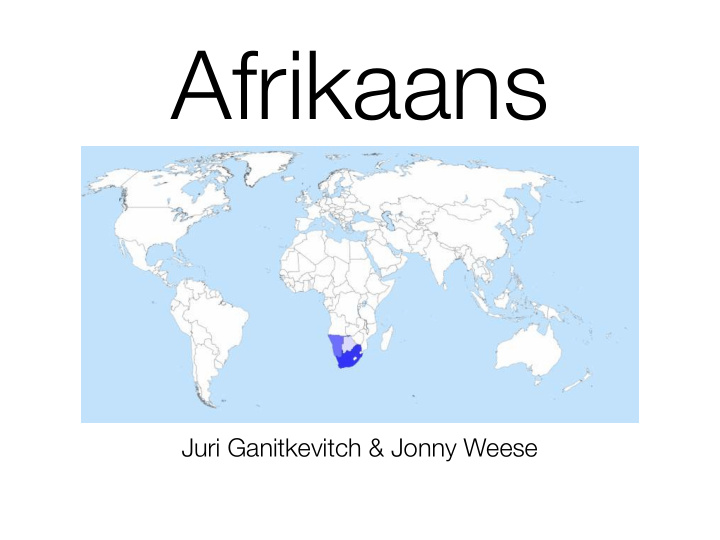



Afrikaans Juri Ganitkevitch & Jonny Weese
Demographics & History • ~6 million native speakers in South Africa & Namibia • ~20 million speakers total • Second-most prevalent language in South-African media • Originated in 17th century Dutch
Linguistics • West Germanic language family • Closely related to Dutch: mutually intelligible • Orthographic simplifications • No gender, simple verb morphology • Influences from Malay, Portuguese, African languages, and South African English
Examples Dutch Afrikaans ik ben , u bent , het is , ... ek is , u is , dit is , ... Ik wiel dit niet doen. Ek wil dit nie done nie . provin cie , poli tie , ... provin sie , poli sie , ...
Afrikaans in MT Dutch-Afrikaans • Rule-based text transformation: morphology, orthography, compounds (’09, ’11) Afrikaans-English • Phrase-based SMT: small parliamentary parallel corpora (’05) • Google Translate: web data & probably rule- based repurposing of Dutch data (’09)
Af-En Parallel Data URL # words ~439k autshumato.sf.net ~700k opus.lingfil.uu.se af.wikipedia.org ~21k articles
References 1. Wikipedia, 2012 2. Rapid rule-based machine translation between Dutch and Afrikaans. P . Otte & F. Tyers, 2011 3. Processing Parallel Text Corpora for Three South African Language Pairs in the Autshumato Project. H. J. Groenewald & L. du Ploy, 2010 4. Rule-based Conversion of Closely-related Languages: A Dutch-to- Afrikaans Convertor. G. van Huyssteen & S. Pilon, 2009 5. Rapid Development of an Afrikaans-English Speech-to-Speech Translator, H. Engelbrecht & T. Schultz, 2005 6. The OPUS corpus - parallel & free. J. Tiedemann & L. Nygaard, 2004
Dankie.
Language Presentations • Teams of two • Pick a language and a date • Email us: juri@cs.jhu.edu • First come, first served • Due: 11:59pm on Sunday, 2/12
Recommend
More recommend